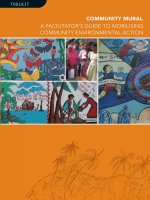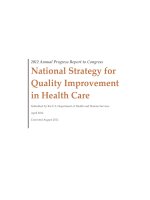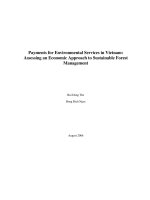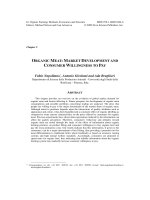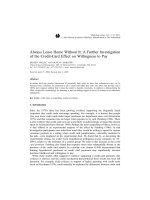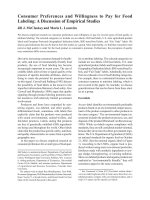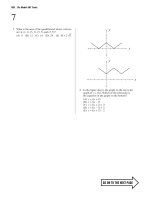Household’s willingness to pay for environmental improvement in van phuc traditional handicraft village – ha noi using contingent valuation method (CVM)
Bạn đang xem bản rút gọn của tài liệu. Xem và tải ngay bản đầy đủ của tài liệu tại đây (595.87 KB, 77 trang )
THAI NGUYEN UNIVERSITY
UNIVERSITY OF AGRICULTURE AND FORESTRY
NGUYEN THE TUNG
TOPIC TITLE:
“HOUSEHOLD’S WILLINGNESS TO PAY FOR ENVIRONMENTAL
IMPROVEMENT IN VAN PHUC HANDICRAFT VILLAGE – HA NOI
USING CONTINGENT VALUATION METHOD (CVM)”
BACHELOR THESIS
Study Mode
: Full-time
Major
: Environmental Science and Management
Faculty
: International Training and Development Center
Batch
: 2011-2015
Thai Nguyen, Sept. 2015
DOCUMENTATION PAGE WITH ABSTRACT
Thai Nguyen University of Agriculture and Forestry
Degree Program
Bachelor of Environmental Science and Management
Student name
Nguyen The Tung
Student ID
DTN1153150089
Thesis Title
Household’s willingness to pay for environmental improvement
in Van Phuc traditional handicraft village – Ha Noi using
Contingent Valuation Method (CVM)
Supervisor
Ph.D. Nguyen Nghia Bien
Abstract:
This research investigated the willingness to pay for environmental quality
improvement in Van Phuc handicraft village - Ha Dong - Ha Noi using the contingent
valuation method. According to the survey result, Van Phuc handicraft village is
affecting by the environmental pollution. Moreover, the environmental pollution in
Van Phuc handicraft village often contaminated by the waste, mostly comes from
handicraft village activities and industrial activities. However, the villagers are aware
of the environmental pollution in the locality and willing to pay money for
environmental improvement. On average, 88.3% of the households are willing to pay
for improved environmental quality and the average of willingness to pay is 227.641
VND/household/year. The willingness to pay of villager affected by education level,
income, occupation and the amount of household members. In particular, amount of
household member has the clearest impact to the willingness to pay of people living in
Van Phuc handicraft village.
Keywords
Willingness to Pay, Environmental good, Contingent Valuation
Method ; Regression Model
Number of pages
49
Date of Submission
30/9/2015
CONTENTS
LIST OF FIGURES ..................................................................................................... 1
LIST OF TABLES....................................................................................................... 2
LIST OF ABBREVIATIONS ...................................................................................... 3
ACKNOWLEDGEMENT ........................................................................................... 4
INTRODUCTIONNTRODUCTION ........................................................................ 5
1. Rationale ................................................................................................................. 5
2. Aim and Objectives ................................................................................................. 7
3. Scope and limitation ................................................................................................ 8
4. Research structure.................................................................................................... 8
CHAPTER I: LITERATURE REVIEW ................................................................ 10
1.1. Environment ....................................................................................................... 10
1.2. The total economic value of environmental resources ......................................... 12
1.3. The methods for valuation of environmental resources ....................................... 14
1.4. Consumer surplus ............................................................................................... 15
1.5. Willingness to Pay .............................................................................................. 17
1.6. Contingent Valuation Method ............................................................................. 19
CHAPTER II: RESEARCH METHODS ............................................................... 28
2.1. Methods of data collection .................................................................................. 28
2.1.1. Secondary data collection................................................................................. 28
2.1.2. Primary data collection .................................................................................... 28
2.2. methods for data analysis .................................................................................... 29
2.2.1. Descriptive statistical method........................................................................... 29
2.2.2. Comparative statistical method ........................................................................ 29
2.2.3. Contingent Valuation Method .......................................................................... 30
2.2.4. WTP regression model ..................................................................................... 32
CHAPTER III: RESEARCH RESULTS AND DISCUSSION ............................. 35
3.1. Basic information about Van Phuc Handicraft village ......................................... 35
3.1.1. Location, physical and socio-economic condition ............................................ 35
3.1.2. Major economic features .................................................................................. 36
3.1.3. Current environmental status............................................................................ 38
3.2. sample household reated information .................................................................. 40
3.2.1. Income ............................................................................................................. 40
3.2.2. Age and educational level ................................................................................ 41
3.2.3. Number of household members ........................................................................ 41
3.2.4. Gender ............................................................................................................. 41
3.2.5. Occupation ....................................................................................................... 42
3.3. The information related to household willingness to pay for environmental
improvement status: ................................................................................................... 42
3.3.1. Current environmental situation ....................................................................... 42
3.3.2. The awareness of responder ............................................................................. 44
3.3. estimation of The household willingness to pay for environmental improvement 48
3.4. analysis of factors affecting people’s WTP in van phuc handicraft village .......... 52
3.5. Analyzing the statistical significance .................................................................. 55
3.5.1. Education Level ............................................................................................... 55
3.5.2. Income ............................................................................................................. 56
3.5.3 Amount of household member .......................................................................... 57
3.5.4. Occupation ....................................................................................................... 57
3.5.6. Improving the education and raising the awareness of the people ..................... 60
3.5.7. Increasing people income and their living standards......................................... 61
3.5.8. Strengthening the population - family planning ................................................ 62
3.5.9. Propagating measures in various forms to people ............................................. 62
CONCLUSION ........................................................................................................ 63
REFERENCES ........................................................................................................ 66
LIST OF FIGURES
Figure 1.1. Categories of economic values attributed to environmental assets ........... 13
Figure 1.2 Consumer surplus illustrating consumer (red) and producer (blue)
surpluses on a supply and demand chart.................................................... 16
Figure 1.3. The willingness to pay and consumer surplus ......................................... 18
Figure 3.1. Artisan and weaving loom. ..................................................................... 36
Figure 3.2. Untreated wastewater has been directly discharged into the
environment. ............................................................................................. 38
Figure 3.3. Silk making process ................................................................................ 40
Figure 3.4. The rating of interviewees about the environmental situation (Unit:
percentage) ............................................................................................... 42
Figure 3.5. Responder’s awareness of environmental services and payments for
environmental services (Unit: people)....................................................... 44
Figure 3.6. Proportion of people were participate in training in environmental
services and payments for environmental services (Unit: percentage) ....... 46
Figure 3.7. Result of the Regression Analysis using.................................................. 53
1
LIST OF TABLES
Table 3.1 The information related to the interviewees ................................................ 41
Table 3.2. Source of pollution .................................................................................... 43
Table 3.3. Impact of environmental pollution ............................................................ 44
Table 3.4. Some environmental services has been known. ......................................... 45
Table 3.5. Incoming source of information about environmental services. ................. 46
Table 3.6. Awareness of interviewees on paying the fee for environmental services .. 47
Table 3.7. Forms of benefit from environmental services........................................... 47
Table 3.8. Number of agree and disagree for payments for environmental services.... 48
Table 3.9. Reason for not willingness to pay .............................................................. 48
Table 3.10. The reasons for the willingness to pay for environmental services........... 49
Table 3.11. The level of willingness to pay of household ........................................... 49
Table 3.12. The reason for the chosen level of WTP. ................................................. 51
Table 3.13. Forms of payment for environmental improvement. ................................ 51
Table 3.14. Correlation matrix between the independent variables ............................. 52
Table 3.15. Summarized result of the Regression Analysis using STATA 11.0.......... 54
2
LIST OF ABBREVIATIONS
BV
: Bequest Value
BOD
: Biological oxygen demand
CS
: Consumer Surplus
CVM
: Contigent Valuation Method
COD
: Chemical oxygen demand
DUV
: Direct Use Value
IUV
: Indirect Use Value
EV
: Existence Value
MP
: Market Price
MoF
: Ministry of Finance
MoST
: Ministry of Science and Technology
MARD
: Ministry of Agriculture and Rural Development
NUV
: Non Use Value
OV
: Option Value
PFES
: Payment for Enviroment Services
TEV
: Total Economics Value
TUV
: Total Use Value
UV
: Use Value
IUV
: Indirect Use Value
WTP
: Willingness To Pay
3
ACKNOWLEDGEMENTS
First and foremost, I wish to express our sincere thanks to the boards of Thai
Nguyen University of Agriculture and Forestry, Dean of Advanced Education Program
for providing us all the necessary facilities and all the teachers who built us the
scientific knowledge to complete the research.
In particular, I would like to thank my principal supervisor Ph.D. Nguyen Nghia
Bien, Director of Forest Inventory and Planning Institute, who guided me
wholeheartedly when I implement this research project.
I would like to thank the leaders of People's Committee of Van Phuc ward and
people of Van Phuc handicraft village for help and provide valuable information to me
in the process of the project implementation.
Last but not least, I take this opportunity to express my deepest thank to my
family and my friends. Due to the limitations of the time and experience, so my own
thesis inevitably have shortcomings. I would like to receive the comments of the
teachers and all of you for the excellent thesis. I sincerely thank you.
Thai Nguyen, June 30, 2015
Nguyễn Thế Tùng
4
INTRODUCTION
1. RATIONALE
Van Phuc handicraft village has a long tradition of weaving, with over 700
establishments involved in the silk production. Moreover, there are more than 22
establishments have responsibility for bleaching and dyeing for the entire village every
day. In the early years of the 90s, traditional looms crafts were replaced by industrial
looms, making the production increased several times in comparison with the textile
craft. Along with to the immediate benefits, it also has long-term effects on the health
of people. Typical of these are rancid noise pollution.
In the past, the artists often use dyes or bleaches made of plants, leaves, flowers
or fruits. Today, villagers are using chemical materials instead of folk materials. The
main materials are silk ranked by category and woven fabric. Specifically, polyester,
cotton and fibers mixed with PE/Co are used for weaving coarse, towel, gauze… In the
process of weaving, dyeing and printing, villagers use a lot of chemicals, dyes such as:
Javen, CH3COOH, H2S, acid dyes, sulfur dyes (rock, Na2S), direct dyes ... and a lot of
water. The hazardous waste is being discharged into the environment directly without
going through any remedial measures, including the use of rudimentary filtering tank.
The BOD and COD in the effluent discharged from Van Phuc village hundreds of
times higher than the standard allow. The amount of untreated wastewater production
and domestic wastewater directly flows into Nhue River. Another factor that
contributes to environmental pollution as components in silk, by the stage of bleaching
which emit 25% impurities, 1 meter of silk with the weight of 80 grams discharges 20
grams of water contaminants… It is evidenced that, in the village of weaving, dyeing
5
the common diseases of the respiratory tract is 10 - 20%, 10-20% of eye diseases, 1030% of gynecological diseases, and 10- 20% of diseases of the gastrointestinal tract.
The noise pollutant also is a big problem in Van Phuc village, the observation
noise results measured at Van Phuc is 100 dB. The noise mainly generated by
operating textile and strand machines, the collision of the wheel spindle and fiber to
fiber tube. The need of improving environmental conditions in Van Phuc handicraft
village has become essential and critical.
In this regard, the concept of willingness to pay (WTP) and contingent valuation
method (CVM) are used. WTP is an important concept of economic valuation in
environmental goods. The concept is “if good is worth having, then it is the maximum
amount that a person state they are willing to pay for a good (DFID, 1997)”. This
principle is conceptually simple and intuitive, even if not always easy to undertake,
and its theoretical foundations can be located in conventional economic theory. As
WTP values benefits in monetary terms, outcomes are comparable across all principles
and are directly commensurate with costs. By way of precedent, environmental
economists have already found the approach helpful in quantifying gains and losses in
circumstances where, for whatever reason, market prices cannot be assigned to
economic activities (Emma J. Frew, et al. 2005). The concept extends to
environmental resources like water quality and natural resources like trees. The key
assumption is that environmental values are anthropogenic. Whatever people evaluate
the environment is worth is what it is worth. Economic methods can be used to attach
estimates of willingness to pay to changes in the level of environmental quality and
natural resource use. The use of the willingness-to-pay (WTP) technique as a means of
6
evaluating health care technologies and environment has been increasing. WTP is now
used in interdisciplinary studies for multi-purposes.
CVM is used to estimate economic values for all kinds of ecosystem and
environmental services. It can be used to estimate both use and non-use values, and it
is the most widely used method for estimating non-use values. It is also the most
controversial of the non-market valuation methods. CNM involves directly asking
people, in a survey, how much they would be willing to pay for specific environmental
services. In some cases, people are asked for the amount of compensation they would
be willing to accept to give up specific environmental services.
It is called
“contingent” valuation, because people are asked to state their willingness to pay,
contingent on a specific hypothetical scenario and description of the environmental
service. The contingent valuation method is referred to as a “stated preference”
method, because it asks people to directly state their values, rather than inferring
values from actual choices, as the “revealed preference” methods do. The fact that CV
is based on what people say they would do, as opposed to what people are observed to
do, and is the source of its greatest strengths and its greatest weaknesses.
The study “Household’s willingness to pay for environmental improvement in
Van Phuc handicraft village – Ha Noi using Contingent Valuation Method (CVM)” is
carried out to understand people’s perception and attitude towards prevailing
environmental problem and improvement of environmental quality in this area.
2. AIM AND OBJECTIVES
The purpose of this research is to understand the household’s willingness to pay
for environmental improvement in Van Phuc handicraft village – Ha Noi.
Specific objectives are:
7
a) To identify environmental issues emerging in Van Phuc handicraft village –
Ha Noi.
b) To estimate household’s willingness to pay for environmental improvement in
Van Phuc handicraft village – Ha Noi.
c) To analyses factors affecting the level of WTP.
d) To draw recommendations for environmental improvement in traditional
handicraft village.
3. SCOPE AND LIMITATION
The study takes place in Van Phuc ward – Ha Dong district– Hanoi. It focuses on
understanding the issues related to the environmental situation in the locality and on
the WTP estimates of local people for improving the environmental quality using
CMV approach; and analysis of the impact of various factors on WTP. On the other
hand, refers to not only those directly involved in the silk weaving, but also the people
who are not extraneous.
Prepared questionnaires were used to interview directly people live in Van Phuc
handicraft village during the period from March to early May 30/2015.
4. RESEARCH STRUCTURE
Besides the introduction and conclusion, this thesis includes 3 chapters:
Chapter I: Literature review
The contents of chapter I are about the fundamental issues in the valuation of
environmental resources. Providing some methods of valuation of environmental
resources. The last part of the chapter will go into contingent valuation method
(CVM).
8
Chapter II: research methods
Chapter II mainly focuses on the methods of data collection and analysis. In this
chapter, we will express the method need to be used in this study and the regression
model.
Chapter III: research results and discussion
This chapter begins with the natural, socioeconomic characteristics of Van Phuc
handicraft village. The next past focuses on the analysis of survey results and analyze
the factors affecting household’s WTP. At the end of chapter III, we give some
recommendations to management and better protection of environmental resource.
9
CHAPTER I: LITERATURE REVIEW
1.1. ENVIRONMENT
There are many different perceptions and concept of environment expressed by
different organizations and individuals
According to Albert Einstein (1870 - 1955 Nobel Economics- 1921), “the
environment is everything except me”.
Mans and Langenhim (1957) state that, the environment is a combination of
existing elements around creatures and affect organisms. For example: flowers grow in
the forests affected by certain conditions such as temperature, light, air, soil, minerals,
trees besides, animals, wind...
Similarly, Joe Whitenney (1993) expresses that environment is everything
outside the body have closely related and influenced the survival of humans as soil,
water, air, sunlight, forest, sea, stories ozone, biodiversity...
Environment is a combination of conditions and external influences impact on
the life and evolution of living organisms. Life is manifested through the process of
metabolism, energy, information, processes and genetic variation, the adaptation,
development and destruction.
For more broadly, the natural environment is one of the group gathers natural
elements, including: a space with the material factors that fluctuate in space, one or
more sources of energy to control these factors and time. The volatile elements in
space and time are: soil, water, air, biological, geological and climatic conditions.
Environment includes three spheres, as follows:
10
- Atmosphere: the air layer envelops the earth, divided into several levels
according to difference height and temperature. Atmosphere protects organisms from
being influenced by solar radiation and maintain the thermal balance of the earth,
transports the water in the global hydrological cycle, provides oxygen for life, CO2 for
photosynthesis and reserves the nitrogen.
- Hydrosphere: the surface area of the entire earth including oceans, seas,
rivers, streams, ponds and lakes.
- Geospatial: the hard outer rocky crust of the earth.
The environment also is a special commodity which provides many services for
the economy, such as water supply for drinking, production and irrigation ...; But in
many cases, the environment is a public good, everyone can use it without affecting
other individuals, such as the atmosphere, everyone has the right to breathe but cannot
prevent other people breathe. Currently, environmental is providing a lot of services
without cost or much lower than the real value, so it leads to overuse or intentionally
or unintentionally hurt the environment. Following to the law of environmental
protection of Viet Nam government, Article 4 - 55/2014/QH13. Organizations,
households and individuals are obliged to contribute financially to environmental
protection if they use components of the environment or to be benefited from the
environment. Thus, the pricing environment has an important role to allocate and use
resources rationally and protect the environment.
Environmental valuation is assigned a monetary value for the goods or services
or the effects of environmental change due to environmental quality. Valuing the
environment helps us to identify and quantify impacts that not quantified in benefit
11
analysis - cost or value can be provided with money and not provided money. The
main objective of the valuation of environmental resources is to find the money that
individuals or society willing to pay for goods, resources and the environment. To get
a better understanding in the valuation of environmental resources, we will discuss the
following sections:
1.2. THE TOTAL ECONOMIC VALUE OF ENVIRONMENTAL RESOURCES
Incorporating environmental concerns into economic decisions involves two
basic steps. First, the “with” and “without” project scenarios are compared to identify
the physical impacts (broadly defined to include also ecological and social effects) of a
given economic activity. Engineers, biologists, social scientists, and other experts are
required to determine such impacts. Economically valuing such physical impacts
constitutes the second step in the environment-economic analysis, and described
below.
Conceptually, the total economic value (TEV) of a resource consists of its (i)
use value (UV) and (ii) non-use value (NUV). Use values may be broken down further
into the direct use value (DUV), the indirect use value (IUV) and the option value
(OV) (potential use value). One needs to be careful not to double count both the value
of indirect supporting functions and the value of the resulting direct use. We may
write:
TEV = UV + NUV
Or
TEV = [DUV + IUV + OV] + [NUV]
12
Figure 1.1. Categories of economic values attributed to environmental assets
(Source: Munasinghe 1992)
Figure 1.1 shows the disaggregation of TEV in schematic form. A short
description of each valuation concept and a few typical examples of the underlying
environmental resources, are provided:
• direct use value is the contribution to current production/consumption;
• indirect use value includes benefits from functional services that the
environment provides to support current production/consumption (e.g., ecological
functions like nutrient recycling);
• option value is the willingness to pay for an unutilized asset, simply to avoid
the risk of not having it available in the future; and
• non-use value is the willingness to pay for perceived benefits not related to use
value, e.g., existence value, which is based on the satisfaction of merely knowing that
an asset exists, even without intending to use it.
13
The economic theory clearly defines TUV but there is considerable overlap and
ambiguity in the breakdown categories, especially with regard to non-use values. Thus,
option values and non-use values are shaded in the figure. These categories are useful
as an indicative guide, but the goal of practical estimation to measure TUV rather than
its components.
The distinction between use and non-use values is not always clear. The latter
tend to be linked to more altruistic motives. Differing forms of altruism include
intergenerational altruism, or the bequest motive; interpersonal altruism or the gift
motive; stewardship (which has more ethical than utilitarian origins); and “q” altruism,
which states that the resource has an intrinsic right to exist. This final definition is
outside conventional economic theory, and incorporates the notion that the welfare
function should be derived from something more than purely human utility.
Through the willingness to pay of individuals will represent a valuable part of the
total economic value that they assess the environmental resources. However, the component
values also greatly depend on the questions: “how much they would be willing to pay?
1.3. THE METHODS FOR VALUATION OF ENVIRONMENTAL RESOURCES
Environment has a lot of basic functions including: providing of resources, absorb
waste, the living space, landscaping… and these functions always have value. However, the
economic function as providing valuable resources is already in the market price but the waste
absorption function, the living space, landscaping and other functions have no market price.
Because these functions not been fully evaluated which lead to excessive exploitation, natural
resources depletion, environmental pollution. Because of this reason, a lot of value assessment
method of environmental resources has been made in order to exploit and use them sparingly
and effectively such as:
14
* The concept of analyzing the benefit - cost
* Travel cost method
* Random classification method
* Benefit transfer method
* Contigent Valuation Method
The main method to estimate the “Household’s willingness to pay for
environmental improvement in Van Phuc handicraft village – Ha Noi” is the Contigent
Valuation Method.
1.4. CONSUMER SURPLUS
Economist Paul A. Baran introduced the concept of "economic surplus" to deal
with novel complexities raised by the dominance of monopoly capital. With Paul
Sweezy, Baran elaborated the importance of this innovation, its consistency with
Marx's labor concept of value, and supplementary relation to Marx's category of
surplus value.
On a standard supply and demand diagram, consumer surplus is the area
(triangular if the supply and demand curves are linear) above the equilibrium price of
the good and below the demand curve. This reflects the fact that consumers would
have been willing to buy a single unit of the good at a price higher than the
equilibrium price, a second unit at a price below that but still above the equilibrium
price, etc., yet they in fact pay just the equilibrium price for each unit they buy.
Likewise, in the supply-demand diagram, producer surplus is the area below the
equilibrium price but above the supply curve. This reflects the fact that producers
would have been willing to supply the first unit at a price lower than the equilibrium
15
price, the second unit at a price above that but still below the equilibrium price, etc.,
yet they in fact receive the equilibrium price for all the units they sell.
Figure 1.2 Consumer surplus illustrating consumer (red) and producer (blue)
surpluses on a supply and demand chart.
Consumer surplus is the difference between the maximum price a consumer is
willing to pay and the actual price they do pay. If a consumer would be willing to pay
more than the current asking price, then they are getting more benefit from the
purchased product than they initially paid. An example of a good with generally high
consumer surplus is drinking water. People would pay very high prices for drinking
water, as they need it to survive. The difference in the price that they would pay, if
they had to, and the amount that they pay now is their consumer surplus. Note that the
utility of the first few liters of drinking water is very high (as it prevents death), so the
first few litres would likely have more consumer surplus than subsequent liters.
The maximum amount a consumer would be willing to pay for a given quantity
of a good is the sum of the maximum price they would pay for the first unit, the
(lower) maximum price they would be willing to pay for the second unit, etc.
16
Typically these prices are decreasing; they are given by the individual demand curve.
For a given price the consumer buys the amount for which the consumer surplus is
highest, where consumer surplus is the sum, over all units, of the excess of the
maximum willingness to pay over the equilibrium (market) price. The consumer's
surplus is highest at the largest number of units for which, even for the last unit, the
maximum willingness to pay is not below the market price/
The aggregate consumers' surplus is the sum of the consumer's surplus for all
individual consumers. This can be represented graphically as shown in the above
graph of the market demand and supply curves.
1.5. WILLINGNESS TO PAY
Willingness (and ability) to pay is the foundation of the economic theory of
value. The idea is, if something is worth having, then it is worth paying for. The idea
extends to environmental resources like water quality and natural resources like trees.
The key assumption is that environmental values are anthropogenic. Whatever people
think the environment is worth is what it is worth. Economic methods can be used to
attach estimates of willingness to pay to changes in the level of environmental quality
and natural resource use.
Typically, an individual often pays for goods and services that they consume by
the market price (MP). But there are some individual voluntary/ willing to pay higher
the price of goods/services than the market price and there are some different in price
they are voluntary/willing to pay. The willingness to pay is a measure of satisfaction or
the satisfaction of consumer about the goods/service. So the demand is described as
the line "willingness to pay". The demand line (D) also provide the foundation for the
determination of social benefits from the given consumption or purchase a
17
commodity/service. The area below the demand line from value 0 to amount
consumed Q* represents the sum of willingness to pay (WTP) and that relationship is
reflected in the following expression:
WTP = MP + CS
With: WTP: The willingness to pay
MP: Market price
CS: Consumer surplus
P
Pa
CS
(a)
P*
MP
D
(b)
O
Q*
Q
Figure 1.3. The willingness to pay and consumer surplus
Figure 1.3 shows that the market price at the balance towards to a
service/commodity X is P* and it is applicable to everyone. However an individual A
may be willing to pay at a price Pa, also higher than the P*. In fact, the general
benefits that person A received here are the entire area (a) and (b). The area (a) is the
consumer surplus, the area (b) the total cost of individual A pay for using merchandise
X.
18
Consumers shall be entitled to consumer surplus mainly because of they have to
pay an equal amount for each unit of goods. The value of every goods unit are equal
the value of last unit. But according to the basic law of diminishing marginal utility,
the utility level for consumer goods is reduced from the first to the last unit. Thus,
consumers would enjoy a surplus amount of utility for every goods unit standing
before their last unit purchased (Samuelson and Nordhaus 2002).
However the willingness of an individual to pay for environmental goods will not
be affected by the market price. Since most of the environmental goods are entirely or
not completely public goods so there are no market price. Thus, in order to assess the
willingness of individuals to pay for the goods mentioned above, there is no measure
of particular value available at the moment, it means that to learn the monetary
measure of the value that individuals associated with commodity market, we must use
many different facilities.
1.6. CONTINGENT VALUATION METHOD
Today, the CVM is one of the most used techniques for valuation of
environmental benefits, widely used by academic institutions as well as by
governmental agencies as a crucial tool in cost-benefit analysis and damage cost
assessment. This is partly due to the advantages of CVM compared to other valuation
methods. First, the CVM gives immediately a monetary assessment of respondents’
preferences. Second, the CVM is the only valuation technique that is capable of
shedding light on the monetary valuation of the non-use values, i.e., the benefit value
component of the environmental commodity that is not directly associated with its
direct use or consumption. These values are characterized by having no behavioral
market trace. Therefore, economists cannot glean information about these values
19
relying on market-based valuation approaches. For environmental resources such as
the protection of natural parks or biodiversity-sensitive areas, which play an important
role in guaranteeing the protection of local wildlife diversity, the non-use value
component may account for the major part of the conservation benefits. Ignoring such
values will be responsible for a systematic bias in the estimation (an underestimation)
of the total economic value of the related environment. Third, CVM brings with it the
advantage that environmental quality changes may be valued even if they have not yet
occurred. This implies that the CVM can be a useful advisory tool for policy decisionmaking. Furthermore, the constructed nature of the CVM permits to value
environmental changes even if they have not yet occurred. Therefore, CVM offers a
greater potential scope and flexibility than the revealed preference methods since it is
possible to specify different states of nature (policy scenarios) that may even lie
outside the current institutional arrangements or levels of provision.
Unlike traditional methods, CVM is not a real market through a hypothetical
market in which individuals in the sample is regarded as the actors in that market. This
method applies to public goods for use value and value in use. The value of WTP
depends on the quality of goods describes the environment, when and how to pay
(under the skill of the interviewer) and the elements belonging to the interviewee as
income, the age, level of ... All the information collected are purely accidental.
In the market, we are assuming situations (Scenarios - Scenario). Typically, there
are two assumptions about changes in environmental quality goods. If the environment
is improved, the individual will be asked if they are willing to pay to get the
improvements, and if so how much they WTP for this assumption. And vice versa, if
20
the environmental damage, the individual will be asked if they are willing to pay to
avoid damage to the environment or not, and their WTP if they agree to pay.
The establishments of CVM is the theory of random utility (RUT). According to
the theory, the probability of an individual choosing a commodity in the commodity
group depends on the utility of these good with the utility of other goods (Morrison et
al 1996). In other words, individuals “q” will choose the alternatives “i” instead of the
alternatives “j” if and only if Uiq> Ujq (i, j Є A; A is a set of choices). The utility of a
commodity is seems to depend on the elements observed as a vector of attributes of
goods (x), personal characteristics (s), as well as the elements are unobservable (e).
The component (e) is treated as random variables and assumed to follow a certain
distribution law.
The utility level of commodity “i” can represented this way:
Uiq = V(siq, ciq) + eiq
With:
Uiq: The utility level of commodity “i” of individual q.
V: The function of indirect utility.
siq : The characteristics vectors of .
ciq: The properties vector of the goods in embodiment i.
eiq: The unobserved components.
The probability of choosing alternatives “i":
P (i\i, j Є A) = P[(Viq + eiq) > (Vjq + ejq) ]
With: P: Probability.
P (i \ i, j Є A) is the probability of choosing alternatives “i” instead of “j” in the
set A.
21
